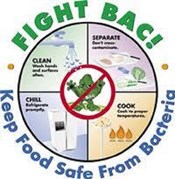Year after year, we hear and read the same advice: Handle food carefully in the summer because foodborne illness — also known as "food poisoning" — is more prevalent in warmer weather. Do foodborne illnesses increase during the summer months? If so, why?
Yes, foodborne illnesses do increase during the summer, and the answer appears to be twofold. First, there are the natural causes. Bacteria are present throughout the environment in soil, air, water, and in the bodies of people and animals. These microorganisms grow faster in the warm summer months. Most foodborne bacteria grow fastest at temperatures from 90 to 110 °F. Bacteria also need moisture to flourish, and summer weather is often hot and humid.
Given the right circumstances, harmful bacteria can quickly multiply on food to large numbers. When this happens, someone eating the food can get sick.
Second, outside activities increase. More people are cooking outside at picnics, barbecues, and on camping trips. The safety controls that a kitchen provides — thermostat-controlled cooking, refrigeration, and washing facilities — are usually not available.
Fortunately, people seldom get sick from contaminated food because most people have a healthy immune system that protects them not only from harmful bacteria on food, but from other harmful organisms in the environment. At the same time, FSIS, other government agencies, and food producers go to great lengths to keep food safe. And, of course, consumers can protect themselves at home with proper refrigeration and thorough cooking of perishable food.
We know foodborne illness increases in warm weather. We also know that consumers can Fight BAC!® by following these four simple steps to safer food in the summertime.
Clean: Wash Hands and Surfaces Often.
Unwashed hands are a prime cause of foodborne illness.
- Wash your hands with warm, soapy water before handling food and after using the bathroom, changing diapers, and handling pets.
- When eating away from home, find out if there's a source of potable (safe drinking) water. If not, bring water for preparation and cleaning. Or pack clean, wet, disposable washcloths or moist towelettes and paper towels for cleaning hands and surfaces.
Separate: Don't Cross-Contaminate.
Cross-contamination during preparation, grilling, and serving food is a prime cause of foodborne illness.
- When packing the cooler chest for an outing, wrap raw meats securely; avoid raw meat juices from coming in contact with ready-to-eat food.
- Wash plates, utensils, and cutting boards that held the raw meat or poultry before using again for cooked food.
Cook: Cook to Safe Temperatures.
Food safety experts agree that food is safely cooked when it is heated for a long enough time and at a high enough temperature to kill harmful bacteria that cause foodborne illness.
- Take your food thermometer along. Meat and poultry cooked on a grill often browns very fast on the outside, so be sure that meats are cooked thoroughly. Check them with a food thermometer.
- Cook all raw beef, pork, lamb and veal steaks, chops, and roasts to a minimum internal temperature of 145 °F as measured with a food thermometer before removing meat from the heat source. For safety and quality, allow meat to rest for at least three minutes before carving or consuming. For reasons of personal preference, consumers may choose to cook meat to higher temperatures.
- Cook all raw ground beef, pork, lamb, and veal to an internal temperature of 160 °F as measured with a food thermometer.
- Cook all poultry to a safe minimum internal temperature of 165 °F as measured with a food thermometer.
- Cook meat and poultry completely at the picnic site. Partial cooking of food ahead of time allows bacteria to survive and multiply to the point that subsequent cooking cannot destroy them.
Chill: Refrigerate Promptly.
Holding food at an unsafe temperature is a prime cause of foodborne illness. Keep cold food cold!
- Cold refrigerated perishable food like luncheon meats, cooked meats, chicken, and potato or pasta salads should be kept in an insulated cooler packed with several inches of ice, ice packs, or containers of frozen water.
- Consider packing canned beverages in one cooler and perishable food in another cooler because the beverage cooler will probably be opened frequently.
- Keep the cooler in the coolest part of the car, and place in the shade or shelter, out of the sun, whenever possible.
- Preserve the cold temperature of the cooler by replenishing the ice as soon as it starts melting.
- If a cooler chest is not an option, consider taking fruits, vegetables, hard cheeses, canned or dried meats, dried cereal, bread, peanut butter, crackers, and a bottle of refreshing beverage.
- Take-out food: If you don't plan to eat take-out food within 2 hours of purchase, plan ahead and chill the food in your refrigerator before packing for your outing.
Leftovers?
Food left out of refrigeration for more than 2 hours may not be safe to eat. Above 90 °F, food should not be left out over 1 hour. Play it safe; put leftover perishables back on ice once you finish eating so they do not spoil or become unsafe to eat.
If you have any doubts, throw it out.
Source: USDA Food Safety and Inspection Service Fact Sheet







